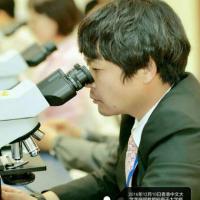| 图片: | |
|---|---|
| 名称: | |
| 描述: | |
- 23岁卵巢肿瘤
Just notice the case. Interesting one.
Morphology and IHC results support it is sex cord tumor. All people above agree. I did a lot of ihc stain studies and cannot find a good marker which can distinguish granulosa tumor and sertoli cell tumor.
Juvenile granulosa cell tumor or sertoli cell tumor? Difficult question.
I agree with Bin that it is a juvenile granulosa cell tumor with focal lutinization. At least I favor this dx based on the photos.
| 以下是引用曹大夫在2010-4-23 22:15:00的发言:
幼年型颗粒细胞不会有索状结构,Sertoli-leydig cell tumor也可以有滤泡样结构的。 Sertoli-leydig cell tumor是人体中组织学最复杂的肿瘤,Leydig 细胞可以很少量。 |
Agree with Dengfeng that sertoli or seroli-leydig cell tumor is a difficult tumor for dx sometimes. They can have a lot of different growth patterns.
In fact granulosa tumor can also have many different growth patterns, including cords or tubules or glands.
However, I do not know if 幼年型颗粒细胞会不会有索状结构 (cords).
Maybe just call granulosa cell tumor.
| 以下是引用zorrokp在2010-6-22 21:43:00的发言: 结果呢,全子老师,期待着呢,谢谢! |
You pasted a questionable case and did not show your final dx.
We as network people can say what we want to say. It is your case. Unfortunately you have to sign out the case and have an explanation to your patient and gynecologist no matter how difficult it is.
Can you share us your final diagnosis? tks.
| 以下是引用cqzhao在2010-7-2 18:30:00的发言:
You pasted a questionable case and did not show your final dx. We as network people can say what we want to say. It is your case. Unfortunately you have to sign out the case and have an explanation to your patient and gynecologist no matter how difficult it is. Can you share us your final diagnosis? tks.
|
-
N Engl J Med. 2009 Jun 10. [Epub ahead of print]
-
Mutation of FOXL2 in Granulosa-Cell Tumors of the Ovary.
1Centre for Translational and Applied Genomics of British Columbia Cancer Agency and the Provincial Health Services Authority Laboratories, Vancouver, BC, Canada
2 Genetic Pathology Evaluation Centre of the Departments of Pathology of the Vancouver General Hospital, British Columbia Cancer Agency and the University of British Columbia and the Prostate Research Centre, Vancouver BC, Canada.
3 Genome Sciences Centre, British Columbia Cancer Agency, Vancouver BC, Canada
4 Department of Pathology, University of Toronto and University Health Network, Toronto, Canada
5 Cheryl Brown Ovarian Cancer Outcomes Unit, British Columbia Cancer Agency, Vancouver, BC, Canada
6 Department of Gynecology, Vancouver General Hospital and British Columbia Cancer Agency, Vancouver BC, Canada,
7 Department of Pathology and Laboratory Medicine, University of Ottawa, Ottawa,Canada
8 Centre de recherche du Centre hospitalier de l'Université de Montréal (CR-CHUM), Montreal, Quebec, Canada
9 Department of Obstetrics and Gynecology, University of British Columbia, Vancouver BC, Canada
10 Department of Gynaecological Oncology, Westmead Hospital and Westmead Institute for Cancer Research, University of Sydney at Westmead Millennium Institute, Westmead NSW Australia
11 Department of Molecular Oncology, British Columbia Cancer Research Centre, Vancouver , British Columbia Canada
12 Department of Biochemistry, University of Alberta, Edmonton, AB, Canada
13 Department of Cellular and Molecular Medicine, University of Ottawa, Ottawa, Canada
14 Department of Pathology, Magee-Women’s Hospital, University of Pittsburgh Medical Center, Pittsburgh, PA, USA
15 Functional Genomics of Ovarian Cancer Laboratory, Cancer Research UK Cambridge Research Institute, Li Ka Shing Centre, Cambridge, UK
-
The authors' affiliations are listed in the Appendix. This article (10.1056/NEJMoa0902542) was published on June 10, 2009, at NEJM.org.
-
BACKGROUND: Granulosa-cell tumors (GCTs) are the most common type of malignant ovarian sex cord-stromal tumor (SCST). The pathogenesis of these tumors is unknown. Moreover, their histopathological diagnosis can be challenging, and there is no curative treatment beyond surgery. METHODS: We analyzed four adult-type GCTs using whole-transc riptome paired-end RNA sequencing. We identified putative GCT-specific mutations that were present in at least three of these samples but were absent from the transc riptomes of 11 epithelial ovarian tumors, published human genomes, and databases of single-nucleotide polymorphisms. We confirmed these variants by direct sequencing of complementary DNA and genomic DNA. We then analyzed additional tumors and matched normal genomic DNA, using a combination of direct sequencing, analyses of restriction-fragment-length polymorphisms, and TaqMan assays. RESULTS: All four index GCTs had a missense point mutation, 402C-->G (C134W), in FOXL2, a gene encoding a transc ription factor known to be critical for granulosa-cell development. The FOXL2 mutation was present in 86 of 89 additional adult-type GCTs (97%), in 3 of 14 thecomas (21%), and in 1 of 10 juvenile-type GCTs (10%). The mutation was absent in 49 SCSTs of other types and in 329 unrelated ovarian or breast tumors. CONCLUSIONS: Whole-transc riptome sequencing of four GCTs identified a single, recurrent somatic mutation (402C-->G) in FOXL2 that was present in almost all morphologically identified adult-type GCTs. Mutant FOXL2 is a potential driver in the pathogenesis of adult-type GCTs.
The work was done by a group for genetic study in Canada. I am only one of the more than 40 authors
More than 97% adult granulosa cell tumors had a missense point mutation in FOXL2 gene, resulting in one amino acid substitution. The mutant FOXL2 is a potential driver in the pathogenesis of adult GCT. Also it may help to diagnose some difficult cases of GCT.
超过97%的成人粒层细胞瘤具有FOXL2基因的错义点突变,该突变导致了一个氨基酸的置换。突变的POXL2是成人粒层细胞瘤一个潜在的发病机理,这有助于一些疑难GCT病例的诊断。The mutation was absent in 49 SCSTs of other types.
The mutation was found in 1 of 10 juvenile-type GCTs (10%). Cannot help to distinguish juvenile GCT from other sex cord stroma tumor, but can be very helpful in distinguish adult GCT from other sex cord stromal tumor
| 以下是引用djdnx在2010-7-4 22:16:00的发言:
请教老师,这样的病例在明确诊断上有一定的困难,是否可以作描述性诊断后,进一步列出倾向性诊断,如(卵巢)性索间质来源恶性肿瘤,倾向于幼年性颗粒细胞瘤(灶性区域黄素化)(或是倾向其他诊断如:中分化支持细胞间质细胞瘤)。 |
| 以下是引用cqzhao在2010-7-5 2:52:00的发言:
|
感谢Dr.Zhao回复和解答。
-
本帖最后由 于 2010-07-13 13:16:00 编辑
目前还没有什么标记可以鉴别男性性索与女性性索,不知道SLCT中,FOXL2有无异常?突变率如何?这个例子从图片看,更倾向于SLCT。JGCT以弥漫性、结节状分布为主,可有大滤泡样结构。因对JGCT的经验比较少,不知道是否可以出现这么多梁索状结构?请问该例患者有无激素分泌异常的症状和体征?AGCT一般有雌激素分泌增多的表现,AGCT内分泌症状相对少些。SLCT可以有雄激素分泌增高的症状,少数也可有雌激素增高。当然,激素异常只是个参考。
另外,Leydig细胞及黄素化间质细胞不仅见于性索间质肿瘤,在其他肿瘤,如上皮癌、囊腺瘤、转移癌中,个别病例也可见到。
好例子,谢谢分享!

- If you have great talents, industry will improve them; if you have but moderate abilities, industry will supply their deficiency. 如果你很有天赋,勤勉会使其更加完美;如果你能力一般,勤勉会补足其缺陷。



















